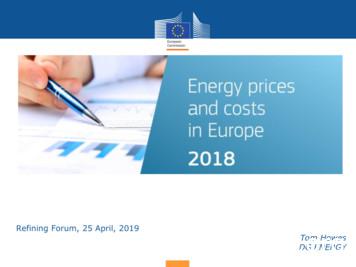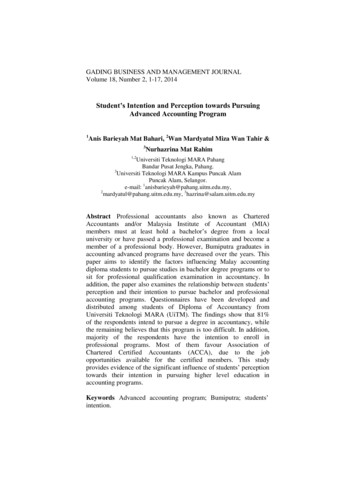Energy Prices And Costs In Europe - European Commission
Energy prices and costs in EuropeRefining Forum, 25 April, 2019Tom HowesDG ENERGY1
Wholesale andinternational pricesThe volatility of international fossil fuels prices impacts the EU energy pricesCrude oil (Brent) and European wholesalegasoline, diesel and heating oil pricesSources: Platts, ECBWholesale electricity prices in the EUSources: Platts, European power markets2
Wholesale andinternational pricesInternational gas and electricity pricesWholesale electricity prices for industrySources: Eurostat, CEIC and IEAEuropean, US and Japanese wholesale gas pricesSources: Platts, Thomson-Reuters
Retail pricesDifferent price structures across MS, fuels and consumer groupsHousehold electricity prices in 2017Industrial electricity prices in 2017Household gas prices in 2017Median and large industrial gas prices in 2017Source: Directorate-General for Energy
Retail prices forindustry - TaxationThe importance of taxation in electricity pricesTaxes on industrial electricity over timeTaxes on industrial electricity in 2017Taxes on electricity in 2017:small vs large industrial consumersSource: DG ENER in-house data collectionSource: Directorate-General for Energy
Costsfor the EU's economyThe energy import bill The EU is stillexposed to volatileglobal fossil fuelmarkets, which canimpact on fiscalregimes andmacroeconomicstability.Source: Directorate-General for Energy
Costs for the industry competitivenessEnergy shares in total production value and real unitenergy costs Energy share of purchasesof energy in the EU stablearound 2% of the totalproduction valueSources: EC, Eurostats Relative real unit energy costsgenerally stable in recent yearsSource: DG JRC and DG ECFIN
Costs for the industry –competitivenessDeclining energy shares in production costs(but still significant for energy intensive sectors)Energy share of productioncosts (range)Examples of sectorsAverage European businessComputers and electronics, motor vehicles, other transportequipmentWaste management and accommodation and restaurantsEnergy intensive sectors in manufacturingCement, lime and plaster, Clay building materials, Pulp and paper,Glass, Iron and steel, Basic chemicals, Non-ferrous metals0-3 %1%3-5 %3-20 %Sources: Trinomics (2018), Ecofys (2018)
Costs for the industry –competitivenessKey plant level result from case studies of EIIs DecliningNb: energy efficiencydirective:2020 Commissionassessment of thepotential for energyefficiency in ion andstorage of energy.Sources: CEPS, Ecofys (2018)
Costs for the industry – energyintensityDeclining energy intensities in most of the energy intensive sectorsSources: Trinomics (2018), Ecofys (2018)
Costs for the industry competitivenessInternational price comparisons over timeRetail electricity prices – EU vs G20Sources: Eurostat, CEIC , ERRA, IEARetail gas prices– EU vs G20
Costs for the industry CompetitivenessInternational comparisons on energy costs and intensityEnergy costs and energy intensity in energy intensive sectorsSources: Trinomics (2018)
Energy Subsidies Public spending, energy subsidiesincreasing to drive the energytransition ( 170 bn in 2016). fossil fuels subsidies not declining.Sources: EC, Trinomics (2018) Wide differences in support tofossil fuels exist in the EU.Sources: EC, Trinomics (2018)
Energy TaxationEnergy taxation provides stable and significant government revenues 280billionper yeari.e. close to5% of taxrevenuesSource: Eurostat
THANK YOU!More information ergy-prices-and-costs
BACK UP SLIDES
Energy prices and costs in Europe This third energy prices and costs report (following 2014, 2016) assessestrends in prices and costs of fuels in Europe, providing background factsand figures for EU energy policy making It updates data (including on 2014 subsidies estimates), adds more data onpetroleum products, and on energy costs, especially for energy intensiveindustries (drawing on DG GROW studies & analysis). It provides evidence supporting the ongoing energy transition (includingthe LTS), and a timely review of taxation, subsidies, revenues and ( / )imports.
Retail pricesDifferences in price dynamics across MS fuels and consumer groupsHousehold electricity prices 2008- 2017Electricity prices for industry in 2008 - 2017Household gas prices in 2008- 2017Gas prices for industry 2008- 2017
Retail prices for industry price regulationPrice regulation : the case for non-household electricity and gas marketsMark-upsMark-ups
Costsfor householdsenergy poverty: energy as a share of household expenditureExpenditure on energy in lower middle income EU households(Euros and share of total expenditure) Spending on energyaverages 5.5%, up to10% Wide differences acrossMember States
Competitiveness - Costsfor the industryEnergy costs and competitiveness at macroeconomic level The EU's overallcompetitiveness remainsstable compared to maintrading partners The reliability and thequality of service of energyis a competitive advantagefor the EU
Costs for the industry –competitivenessRepresentativeness of samples for the plant level analysis
Costs for the industry –competitivenessX-sectorial comparisons in line with x-band comparisonsSource: CEPS, Ecofys (2018)
Prices, costs and investmentsProjections suggest future prices increasingly cover(investment) costs, reducing need for subsidiesSource: Left graph Platts, METIS(2030); right graph: PRIMES
The energy transition - Pricesvs costs and investmentsLooking forward:Investments in electricity capacitySource: Left graph Platts, METIS(2030); right graph: PRIMES
To discuss! Volatile (international) fossil fuel prices still drive EU prices Decarbonisation, long term strategy Price divergence across MS has declined, but can still be significant internal market International position of the EU stable (generally between Asia and fossil fuelproducer countries) international competitiveness Major tax and levy divergences across MS, fuel and consumer group Competition distortions, weak price signals for energy policy goals Energy costs affect macroeconomy, households, industry Imports, / supports, subsidies & price signals Support for level playing field, appropriate subsidies Energy taxes provide revenues Energy subsidies need reviewing (NECPs) and should decline in the future
Industrial electricity prices in 2017 Household electricity prices in 2017 Household gas prices in 2017 Median and large industrial gas prices in 2017 Retail prices Different price structures across MS, fuels a
Prices Effective January 1, 2020 Machine Prices and Speci cations Prices Effective January 1, 2020 ZERO TURN-4 SERIES REVISED MAY 18, 2020. Machine Prices and Secications Prices Eectie anuar , 2 ZT1. Prices F.O.B. Selma, Alabama and Subject to Change Without Notice. ESTATE SERIES
electricity prices between 2012 and 2017. 10. Imbalance prices have caused changes in GB electricity prices in 2016 and 2017. Yet there is no evidence of causality running from imbalance prices to electricity prices over longer periods of time (2012-2017). 11. Imbalance costs do not have a substantial impact on the GB electricity price. 12.
3.1 Recent developments in food prices 3.2 Production costs and producer prices in the food processing industry 3.3 The pass-through along the food supply chain (i) The pass through from agricultural commodity prices to producer prices (ii) The pass trough from producer to consumer prices
2. here to stay? future oil prices remain uncertain 4 2.1 large swings in oil prices are normal, and future prices are highly uncertain 4 2.2 low oil prices provide a short-term economic stimulus overall, but with uneven effects 5 2.3 oil price volatility hurts the economy 5 3. an opportunity to correct course 6 3.1 lower energy prices create an
FISH & WILDLIFE COSTS 17TH ANNUAL REPORT TO THE NORTHWEST GOVERNORS PAGE 3 Figures 08 Figure 1: Costs by Major Area, FY2017, as Reported by Bonneville's Fish and Wildlife Division 09 Figure 2: Costs by Types of Species 10 Figure 3: Costs of FCRPS BiOp Projects 11 Figure 4: Costs Associated with ESA Listed Fish 12 Figure 5: Costs by Fund 13 Figure 6A: Costs by Category
Table 2 The Various Measures of Cost: Thirsty Thelma's Lemonade Stand Average Costs Average costs can be determined by dividing the firm's costs by the quantity of output it produces. The average cost is the cost of each typical unit of product. Average Costs Average Fixed Costs (AFC) Average Variable Costs (AVC)
Annx. 3.6 Gross value added at basic prices by industry of origin, Gross Domestic product at market prices & Gross National Income at constant (2011-12) prices 32 Annx. 3.7 Net value added at basic prices by industry of origin, Net domestic product at market prices & net national income at current prices 33
advanced accounting program. Understanding students’ intentions in pursuing their studies to higher level of accounting courses is an important step to attract students to accounting courses. Beside intention, students’ perception on advanced accounting programs and professional courses may






















